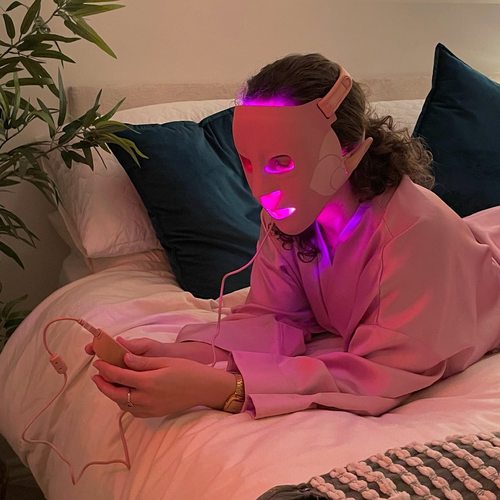LED face masks have become widely popular with celebs like Victoria Beckham, Jessica Alba Chrissy Teigen and Kate Hudson all singing their praise. But what are they, and how do they really work? Plus, are they safe for individuals who are not trained facialists to use at home?
What are LED face masks?
The internet’s latest skincare craze, LED face masks, has led numerous skin-tech companies offering at-home light therapy gadgets that pledge impressive results with regular use.
View this post on Instagram
There’s scientific evidence that supports their effectiveness. According to clinical studies, specific light devices can be useful in treating a range of skin concerns like improving collagen production, and managing mild to moderate acne. A small study has even revealed that green light therapy may be effective in reducing melasma and hyperpigmentation.
According to an article by Harpers Bazaar, Dr. Maryam Zamani, an oculoplastic surgeon and founder of MZ Skin says:
“At-home LED masks are an excellent way to bring an in-office treatment to the comfort of your own home. These devices may not be as potent as the LED used in a clinic, but they offer comparable benefits.”
The one important thing about LED face masks to keep in mind, is that it will take a good number of rounds before you start to reap the long-term benefits of the mask. If you can’t afford to see a facialist for regular in-clinic appointments, then buying at home LED masks could work for you…
What is LED light therapy about?
LED light therapy is a non-invasive skin treatment that utilises specific wavelengths of light to treat a range of skin concerns.
Back in the day, light therapy was first developed by NASA to aid in healing wounds in space. Crazy, right? In the 1990s, the US Navy Seals picked up on it and eventually, aestheticians brought it to their treatment rooms, inspired by clinical data that proved LED can help with skin repair, collagen stimulation, age spot fading, and inflammation and acne reduction.
View this post on Instagram
Benefits of LED light therapy:
- Treating acne.
- Regulating natural oil production.
- Stimulating collagen and elastin.
- Minimising redness and wrinkles.
- Reduce dark spots and even out skin tone.
How does it work?
LED therapy makes use of the visible light spectrum, such as blue, yellow, amber, and red, as well as light beyond the visible spectrum to penetrate different skin depths. As the light wavelength increases, the deeper it penetrates into your skin, which absorbs the light through receptors, just as it does with regular skincare.
Each colour of light stimulates different responses within the skin cells, let’s look at what they are:
- Looking for a calming, plumpy effect? Use red LED.
- Struggling with breakouts? Use blue LED.
- Want to minimise swelling? Use amber LED.
- Looking to boost collagen and elastin? Use infrared.
What are the dangers of using LED masks?
Studies on at-home LED face masks are still limited, but one of the main concerns which has popped up, is the risk of the very bright light causing irritation, especially if you’re sensitive to light. It’s important to keep your eyes closed when wearing a mask that covers your face.
LED light therapy is not recommended for people who have seizures or epilepsy, eye conditions, or those taking certain types of antibiotics. If you’re unsure whether LED therapy is suitable for you, it’s best to consult a professional.
ALSO SEE:
My best friend bought me my first vibrator – It changed my life…
Feature Image: Instagram / mzskinofficial

